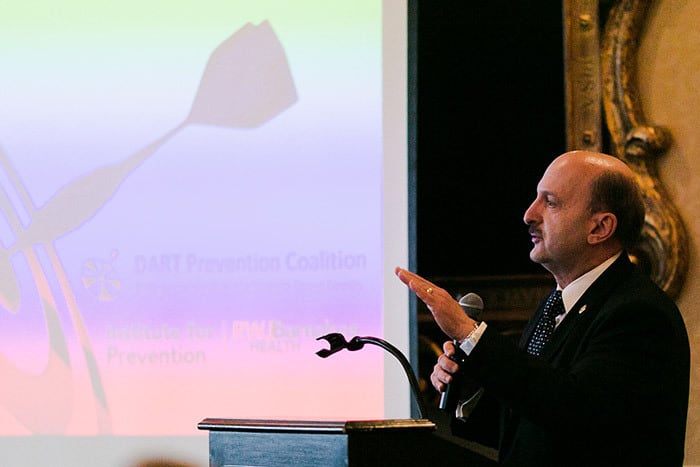
LAKEWOOD – New Jerseyans need to clear the smoke from their eyes and step outside to get some fresh air, and clarity. The high praise coming at Colorado and other marijuana-friendly states silences under the weight of data, according to a former state police officer who has seen it all.
The legalization of “medicinal marijuana” is the gateway law to recreational pot, and any perceived benefits are outweighed by the unknowns and risks, especially to children.
So said Ed Shemelya, a veteran Kentucky State Police officer who is national coordinator for the National Marijuana Initiative. He shared his group’s findings with a packed audience of Ocean County law enforcement, school and municipal officials, as well as health care workers, at Eagle Ridge Country Club recently.
Shemelya gives a similar eight-hour seminar around the country; he squeezed in damning stat after stat into a dizzying one-and-a-half-hour presentation.
“I’m not here to demonize marijuana. We’re here to have an honest, frank discussion with what we’re seeing in this country with marijuana,” Shemelya said. With the new governor Phil Murphy’s promises to bring recreational pot to the state, Shemelya said he wanted to let officials know what’s happening in other states. “I would challenge you as with any speaker, take a look at the data, take a look at the sources, take a look at the sites, and research them yourself.”
Marijuana is the most dangerous drug in America, he said. Shemelya hails from Appalachia, gripped by an opioid epidemic since the late ‘90s, and yet “you’ve got this hillbilly up here telling you [marijuana] is the most dangerous drug in America.”
“Yes, it is,” he said.
More people use marijuana than any other illicit drug combined. But that’s not what makes it dangerous: its danger lies in how misunderstood it is. This isn’t what your parents or grandparents smoked in the parking lot between classes in high school 40 years ago. With a purity of 12 to 15 percent, that stuff can’t even be given away. Buds and leaves have been replaced with wax concentrates, hash oil and edibles, with a THC purity of upwards of 90 percent for concentrates, Shemelya said.
Most the data shared came from Colorado, ground zero of legalized recreational marijuana. They are the ones who started this mess, Shemelya said. “Medical” and recreational dispensaries now outnumber McDonalds and Starbucks in that state. Washington State and Oregon aren’t far behind. Most sales are waxes, concentrates, edibles and vaping.
Even with regulations and safety precautions, the data showed that the fastest growing group of users were children and young adults, ages 12-25. With the lack of research of what THC does to the cerebral cortex—which doesn’t fully mature until age 25—Shemelya fears we won’t know the full damage for another decade. Any research that does exist only measured effects of THC from buds, not the concentrates.
The attitude among children and young adults was this: it can’t be that harmful if it’s legal. The perception that marijuana is safer than alcohol also persists, Shemelya said. And where medical and recreational marijuana is legal, usage rates skyrocket.
Yes, even with the regulations, a thriving black market for pot still exists. Why you pay $50 for a gram, much of that taxed, when you could buy the same for $25 from Joe from his house? Colorado also ships marijuana to 44 states and two foreign countries, Shemelya said has been found. So much marijuana is being produced that they can’t possibly sell it. So someone can buy a gram for $150 and ship it back east and sell it for $9,000.
Ocean County Prosecutor Joseph Coronato spoke at the beginning of the presentation. He said that if pot is legalized in the Garden State, that even those who don’t partake will be impacted.

“I have concerns. It’s easy to say the reason we’re going to legalize it is because it’s a sin tax. It’s something where we’re going to be able to get some money and ‘it’s okay with me because I don’t smoke marijuana, right? If the other people want to smoke marijuana, that’s fine,’” Coronato said. He had further questions as to the legality: How will intoxication be determined? We can measure blood-alcohol levels. At what point is someone “high?” Can Joe be jailed for selling it out of his garage, because the state doesn’t want the competition?
Colorado raked in $219.7 million in marijuana tax money, Shemelya said. But that accounts for less than 1 percent of that state’s total budget. And if for every dollar marijuana brings in, it costs $14 to deal with health and safety concerns, does it pay?
In a way, both men were preaching to a choir. The Ocean County Freeholders passed a resolution against the legalization of recreational marijuana, and no municipality in this mostly “red” county has publicly come out in favor of pot sales. Several have already passed bans ahead of the expected legalization, with others preparing ordinances for passage soon.
The presentation was hosted by the DART Prevention Coalition with the prosecutor’s office and county health department. The DART program started in 2009 with the goal of reducing alcohol-related deaths in young adults in Lakewood, Brick and Toms River. The coalition expanded three years later to include the goal of reducing substance abuse in that age group.






